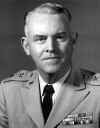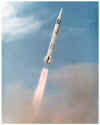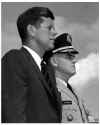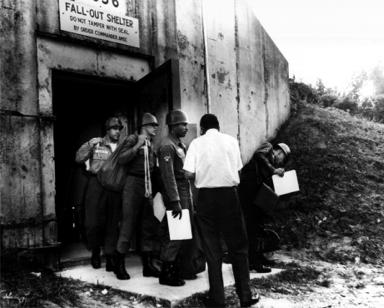1962 (May - Dec)
June 1962 Probably the youngest college graduate ever to work at the U.S. Army Ordnance Missile Command (AOMC) was employed in the Industrial Directorate. Mrs. Diane S. Burrows, 18, entered college when she was 14 years old. She graduated from East Tennessee State College, where she majored in mathematics.
|
5 June 1962 MG Francis J. McMorrow became the first Commanding General of the U.S. Army Missile Command (MICOM). |

|
|
14 June 62 Mrs. Novella S. Billions, Deputy Chief of the Aerophysics Branch of the AOMC Research Laboratory and the only woman project engineer in the Army missile program, directed the firing of a U.S. Army atmospheric sounding probe from Cape Canaveral, Florida. She was the first woman participant in the 12-year history of rocket firings from the Cape. |
|
July 62 Provost Marshal Division patrol cars were equipped with radar for use in gauging the speed of moving traffic on Redstone Arsenal. |
|
1 August 62 MICOM was activated at Redstone Arsenal (RSA) as a Class II activity under the U.S. Army Materiel Command (AMC). MICOM was incorporated with about 19 major missile systems, 8 under project management and the rest under commodity (product) managers. Upon its activation, MICOM also gained juris-diction over three Class II industrial plants: the Charlotte Ordnance Missile Plant in Charlotte, North Carolina; the Michigan Ordnance Missile Plant in Warren, Michigan; and the Tarheel Ordnance Plant in Burlington, North Carolina. At this time, MICOM left the operation of these plants under Ordnance District jurisdiction. |
|
2 August 62 MICOM chose Hughes Aircraft Company as the prime contractor for development of the tube-launched, optically-tracked, wire-guided (TOW) missile system. |
|
13 August 62 The Martin Road overpass began full operation to help ease traffic jams on the arsenal. Part of a program started 2 years earlier when Martin Road was converted to a four-lane highway, the new cloverleaf at Martin and Patton Roads had been opened on a part-time basis since 31 July 62. |
|
29 August 62 Dr. Billy Graham, the internationally known evangelist, drew a record crowd of 35,000 visitors to Redstone Arsenal's airfield during his first Alabama speaking engagement. |
|
3 October 62 All product managers at MICOM were redesignated commodity managers. As a management concept, commodity management fell between project and functional management. It was less intensive and less expensive than the former, but more systems oriented than the latter. |
|
22 October 62 In a televised address on this date, President John F. Kennedy informed the American public about the escalating Cuban missile crisis. Contrary to their earlier denials, the Soviets were installing missile and bomber bases in Cuba. Aerial photographs of these bases were displayed to the United Nations by Ambassador Adlai Stevenson. Representatives of MICOM's Missile Intelligence Agency (MIA) provided the missile expertise needed to identify the type, degree of completeness, and threat posed by the missile bases under construction. In addition, MICOM assisted with the deployment of HAWK units to South Florida as tensions escalated. |
|
24 October 62 The U.S. quarantine of Cuba which became effective on this date in conjunction with the Organization of American States (OAS) vote approving the use of armed force to prevent further missile shipments to Cuba, ultimately convinced Soviet Primier Khrushchev to back down. In exchange for the U.S.S.R.'s promise to withdraw the missiles, the United States agreed to lift the blockade and pledged not to invade Cuba. |
|
24 October 62 The first troop firing of the SERGEANT missile occurred at White Sands Missile Range (WSMR). |

|
|
31 October 62 AMC transferred responsibility for industrial and field support of the Armament System Helicopter SS-11 from WECOM to MICOM. |
|
November 62 The AMC-managed FABMDS, assigned to MICOM for administration, was closed out and the project manager (PM) abolished. |
|
November 62 During the Cuban missile crisis, the 1st U.S. Armored Division designed, fabricated, and installed on two UH-1B helicopters a 2.75-Inch Fixed Fin Aircraft Rocket (FFAR) Armament System. Called upon to evaluate the system, the Ground Support Equipment Laboratory found deficiencies of such magnitude that the systems were declared unsafe. However, the laboratory determined that with certain modifications the systems could be made operational. On 16 November 62, the Ground Support Equipment Laboratory began round-the-clock work to make the systems safe and usable. After successful testing, the two aircraft were released to the 1st Armored Division on 21 November 62. |
|
1 November 62 AMC announced that Ling-Temco-Vought had been selected as the prime contractor for Missile B. |
|
2 November 62 President Kennedy reported that the Cuban missile bases were being dismantled. |
|
20 November 62 The United States lifted its naval blockade of Cuba. |
|
11 December 62 The Michigan Ordnance Missile Plant was reassigned to the Army Mobility Command. This was done to facilitate the joint occupancy of the plant by the Chrysler Corporation and Ling-Temco-Vought, Inc. |
|
11 December 62 Defense Atomic Support Agency (DASA) representatives met with MICOM personnel beginning this date and continuing through 13 December 62 to discuss the possible use of the REDSTONE and CORPORAL systems in future nuclear testing. |
|
14 December 62 The Commanding Generals of the Army Munitions Command (MUCOM) and MICOM met at AMC Headquarters to resolve conflicts in their proposed mission statements. It was agreed to remove from MUCOM's mission statement any assignment of responsibility for rockets and missiles or their supporting technology and components. |
|
14 December 62 The Martin Road extension across U.S. 231 (Memorial Parkway) to Whitesburg Drive opened. |
Excellence in Missilery:
Introduction,
1962,
1963,
1964,
1965,
1966,
1967,
1968,
1969,
1970,
1971,
1972,
1973,
1974,
1975,
1976,
1977,
1978,
1979











